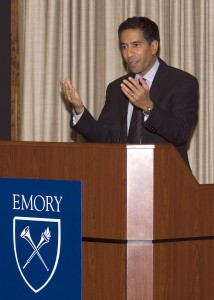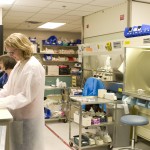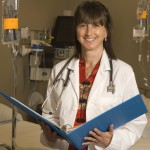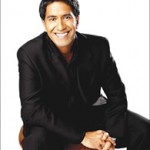Yesterday, Sanjay Gupta, MD, assistant professor of neurosurgery at Emory School of Medicine and associate chief of neurosurgery service at Grady Memorial Hospital, joined Emory and its community in a book-signing event to celebrate his newest book Cheating Death: The Doctors and Medical Miracles that Are Saving Lives Against All Odds.

Dr. Gupta signs his book
It is hard to imagine having a busier schedule than the one Gupta has. On Wednesday he started his day as chief medical correspondent at CNN by discussing the new breast cancer recommendations issued by the U.S. Preventive Services Task Force. He, like other health reporters and doctors across the nation, had hundreds of questions pouring in about the controversial recommendations.
As the late afternoon approached, Gupta packed up for his visit to Emory where several hundred faculty, staff, students and neighbors awaited him for the book-signing event. After spending time presenting and answering questions, and then signing books for many people, Gupta again packed up and headed back to the CNN studio for a live show with Larry King.

Dr. Gupta presents
During his presentation at Emory, Gupta talked about his experiences that led to his book. He notes one CNN story took him to Norway to meet the woman who had been skiing and slipped through a hole in the ice with her head caught under freezing water for an hour.
After an amazing rescue, Anna BÃ¥genholm was taken to the emergency room where the doctors did not give up. A doctor on the helicopter said there was a completely flat line. No signs of life whatsoever. But the team persevered and saved her life by warming her body very slowly. Even though BÃ¥genholm was alive, months of recovery lay ahead. Paralyzed for almost a year until her damaged nerves healed, she today is a radiologist at the hospital where she was saved. She has returned to skiing and other sports.
Read more about Gupta in Emory Magazine. Learn more about Gupta’s stories from on the road.






 The
The 



